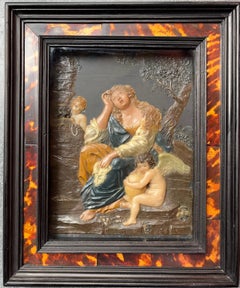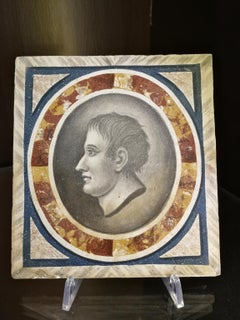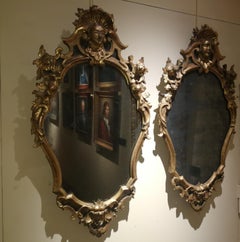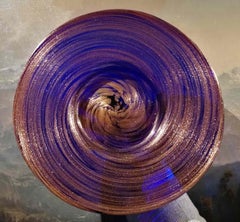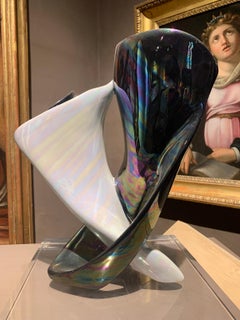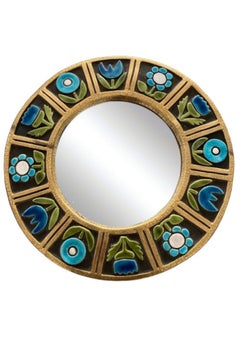GALLERIA MARLETTA More Art
to
7
1
1
Overall Width
to
Overall Height
to
3
2
4
1
1
2
6
5
3
3
2
2
9
Tuscan Mannerist bronze Mortaretto d'allegrezza from the 17th century
Located in Florence, IT
Decorated with a cartouche on which the family coat of arms was probably engraved, this interesting small bronze object is a "cheer mortar" (also called a "mascolo" or "mastio" of ch...
Category
17th Century Mannerist More Art
Materials
Bronze
Baroque wax religious figurative bas-relief from the 18th century
Located in Florence, IT
Polychrome wax relief on chalkboard, 20 x 15 cm; with ebony and tortoiseshell frame, 28 x 23 cm
The scene depicts Mary Magdalene in the center, seated on a rock with a handkerchief i...
Category
Mid-18th Century Baroque More Art
Materials
Slate
Gesso scagliola di stile impero con ritratto maschile napoleonico
Located in Florence, IT
Ritratto del fratello minore di Napoleone Bonaparte, Lucien, realizzato con la tecnica della scagliola, una tecnica di intarsio che, dalla fine del Cinquecento ai primi anni del Seic...
Category
Late 19th Century Other Art Style Portrait Paintings
Materials
Plaster
Coppia di specchi rococò toscane in legno dorato
Located in Florence, IT
Coppia di specchi rococò il legno dorato decorati a volute, racemi floreali, e mascheroni. Hanno mantenuto il loro vetro originale.
Category
18th Century Rococo More Art
Materials
Gold
Piatto in vetro avventurina di Murano blu screziato oro del XX secolo
Located in Florence, IT
Piatto in vetro avventurina di Murano blu cobalto con screziature d'oro per tutta la superficie.
ll vetro avventurina, noto anche come goldstone, è una particolare lavorazione inven...
Category
1920s Other Art Style More Art
Materials
Copper
Vaso in ceramica a lustro di manifattura italiana della metà del Novecento
Located in Florence, IT
Vaso in ceramica a doppia bocca, bianco con interno nero e e nero con interno bianco (37 x 28 x 28 cm). L'effetto opalescente è dovuto alla tecnica "a lustro", un processo che si av...
Category
1950s Other Art Style More Art
Materials
Ceramic
Vaso in ceramica di Salerno smaltata azzurra a tema floreale
Located in Florence, IT
Vaso in ceramica smaltata azzurra (h 33 cm, piede 13 cm, bocca 22 cm) raffigurante rami di edera, campanule azzurre e una cavalletta.
Proveniente da una manifattura di Salerno attiv...
Category
Mid-20th Century Other Art Style More Art
Materials
Ceramic
Allegorical bas-relief in bronze and wood with putto and cornucopia
Located in Florence, IT
Bronze plaque (measurements without the wood are 12 x 20 cm) with bas-relief representing a putto with a cornucopia and the crescent moon. At the bottom runs in capital letters a Lat...
Category
Mid-20th Century Other Art Style More Art
Materials
Bronze
Swiss French Imperial Neoclassic Mantel Clock 19th century
Located in Florence, IT
Imperial Mantel Clock signed on the clock face “Renard suc(cursale) de Frissard, à Rouen”. It’s in gilded bronze and the mechanism is still worki...
Category
1820s Other Art Style More Art
Materials
Gold, Bronze
Related Items
Miroir
Located in PARIS, FR
Sublime glazed ceramic mirror by French ceramist Mithé Espelt, 29 cm in diameter
Category
20th Century Modern More Art
Materials
Ceramic
Flemish Old Master, Study of Donkey Carriage, 17th Century, Sanguine Drawing
Located in Greven, DE
This drawing shows several studies of a donkey with a carriage. Its style is close to Flemish 17th century artists. On the passepartout one reads "Mathias Scheyer/ Jacob Weyer", both...
Category
17th Century Baroque Animal Drawings and Watercolors
Materials
Chalk, Handmade Paper
$851 Sale Price
20% Off
H 7.13 in W 5.52 in
Cloned Cat with pet bottle.
By William Sweetlove
Located in Malmo, SE
Edition of 75 ex.
Acquired directly from the artist.
Free shipment worldwide.
William Sweetlove, born in Ostend, Belgium, in 1949, unites dadaism with surrealism and pop art in hum...
Category
2010s Pop Art Figurative Sculptures
Materials
Resin
Polo Player Bookends in Bronze
Located in Brookville, NY
Polo Bookends in bronze for the sporty library. These were purchased from the collection of a polo player on Long Island who had a beautiful library of sporting books. He also owne...
Category
1960s Academic Figurative Sculptures
Materials
Bronze
Keith Murray "Bombe" Vases in Moonstone (other colors available)
Located in Brookville, NY
Keith Murray, architect and industrial designer, created this particular vase, "Chinese Lantern" in moonstone white ( shape no.3765) Made in England. Priced individually at $1200 each, we have this same vase in Yellow and in Green. A quote can be given for additional pieces. We have yellow green and moonstone in bombe in small and large sizes. We have celadon bowls, yellow bowls, and small moonstone pot with lid. All c. 1935 art deco style made in England. All in excellent condition.
These are the most desirable classic examples of pottery by Architect Keith Murray produced for Wedgwood in the 1930's.
Published and illustrated in the book "Wedgwood Ceramics...
Category
1930s Art Deco More Art
Materials
Clay
$1,200
H 7.5 in W 7 in
Portrait of a Lady in White Chemise, Russet & Blue Drapery c.1695, Oil Painting
By Harman Verelst
Located in London, GB
This lavish portrait, painted circa 1695, is an exquisite example of the type of portrait in vogue during the last quarter of the seventeenth century. It is evident that the artist ...
Category
17th Century Old Masters Portrait Paintings
Materials
Canvas, Oil
$7,996
H 29.14 in W 24.41 in D 1.58 in
Portrait of a Lady in Green Dress & Pearl Jewellery c.1660 Painting John Wright
By John Michael Wright
Located in London, GB
In this exquisite work, painted around the time of the Great Fire of London in 1666, a beautiful young woman is wearing a green dress over a white chemise and a russet-coloured scarf...
Category
17th Century Old Masters Portrait Paintings
Materials
Canvas, Oil
$14,558
H 39.38 in W 33.47 in D 3.15 in
The Birds tapestry
Located in Atlanta, GA
Belgian made, Jacquard woven with relief stitch. Fully lined with rod pocket for hanging.
Cotton and rayon.
Also available with black background. Message for more details.
Measurem...
Category
Late 20th Century Rococo More Art
Materials
Tapestry
Portrait of Gentleman in Armour by Table & Helmut c.1685 Aristocratic Provenance
By Johann Kerseboom
Located in London, GB
Portrait of a Gentleman in Armour beside a Table with Helmut c.1685
Follower or circle of Johann Kerseboom (d.1708)
This exquisite Grand Manner work, presented by Titan Fine Art, wa...
Category
17th Century Old Masters Portrait Paintings
Materials
Canvas, Oil
$11,824
H 59.85 in W 48.43 in D 3.15 in
Pop Art 3D Mosaic Sculpture on Circular Canvas- "Lipse" by Elizabeth Art Candy
By Elizabeth Art Candy
Located in FISTERRA, ES
"Lipse" is a standout piece from Elizabeth Art Candy’s Fake Gum’s series, where her signature 3D mosaic technique transforms one of her most iconic subjects—the lips—into a playful, ...
Category
2010s Pop Art Abstract Sculptures
Materials
Clay, Canvas
$425 Sale Price
40% Off
H 2.37 in Dm 11.82 in
"Jeux Galants" (Gallant Players) Tapestry
By Jean-Honoré Fragonard
Located in Atlanta, GA
This is one of the famous scenes inspired by the gallant country compositions by Jean-Honoré Fragonard. This scene, full of wit, vitality and charm is representative of the tone of t...
Category
Late 20th Century Rococo More Art
Materials
Tapestry
Portrait of a Gentleman, Doublet & White Ruff, Gloves Inscribed 1624, on panel
By Frans Pourbus the Younger
Located in London, GB
Titan Fine Art presents this exquisite oil on panel portrait depicting a handsome young gentleman in an exuberant black damask doublet. The pose, with one hand holding gloves and the other akimbo, was one that was well-established for gentleman of the upper echelons of society by the time this work was painted. The principle governing portraits at this time was the recording and defining in visual terms of the position of a sitter in society. In addition to brilliant and complex symbols of luxury, they often contained many symbolic elements too; the inclusion of gloves was often used in portraits that celebrated a betrothal as in ancient times gloves were used to seal a marriage contract.
The extraordinary costume of a black shimmering doublet, the brilliant white reticella ruff, and the cuffs edged with lace were immensely costly… this attire proclaims to every onlooker that this is a superior being. The rendering of the reticella lace ruff is exquisite and the artist has recorded the design that runs through the black damask fabric with meticulous attention to detail. The preservation of this black pigment is remarkable considering the age of the work. Black pigments are especially vulnerable to fade and wear over time partly due to environmental condition but also from unprofessional cleaning. This work is an exquisite example from the period.
According to the inscription in the upper right, the gentleman was in his 22nd year of age in 1624. The coat of arms, which is displayed without a crest, may be ‘blazoned’ in the language of heraldry, as: Sable on a Chevron between in chief two Roundels and in base a Billet [or possibly Square] Or three Martlets Sable. In plainer English this means a black (Sable) background, spanned by a gold (Or) chevron, above which are two golden solid circles (Roundels), and below which is a gold rectangle (Billet); on the chevron are three small black birds (Martlets). Martlets are a stylised form of heraldic bird, believed to be based on the swift, which are conventionally drawn with small tufts instead of feet. In Continental Europe it is also conventional for them to be drawn without beaks, as appears to be the case here. The birds in this instance also have a vaguely duck-like appearance.
Five families have been identified with very close armorial bearings to the one in our portrait. They are the (van) Houthem’s (of Brabant), the Prévinaire’s (of Flanders and Holland), and the Proveneer’s (of Liège) and it must be noted that the locations of these families also fit with the painting’s Flemish origins. However the French Grenières’s (of Île-de-France) and the Jallot’s (of Normandy) are the next closest matches and plausible matches, as Frans Pourbus had settled in Paris just a few years before our portrait was painted.
This painting has been assessed by a professional conservator prior to going on sale, and as thus, it can be hung and enjoyed immediately.
Frans Pourbus the Younger...
Category
17th Century Old Masters Portrait Paintings
Materials
Oil, Wood Panel
$18,249
H 42.13 in W 31.11 in D 3.94 in

